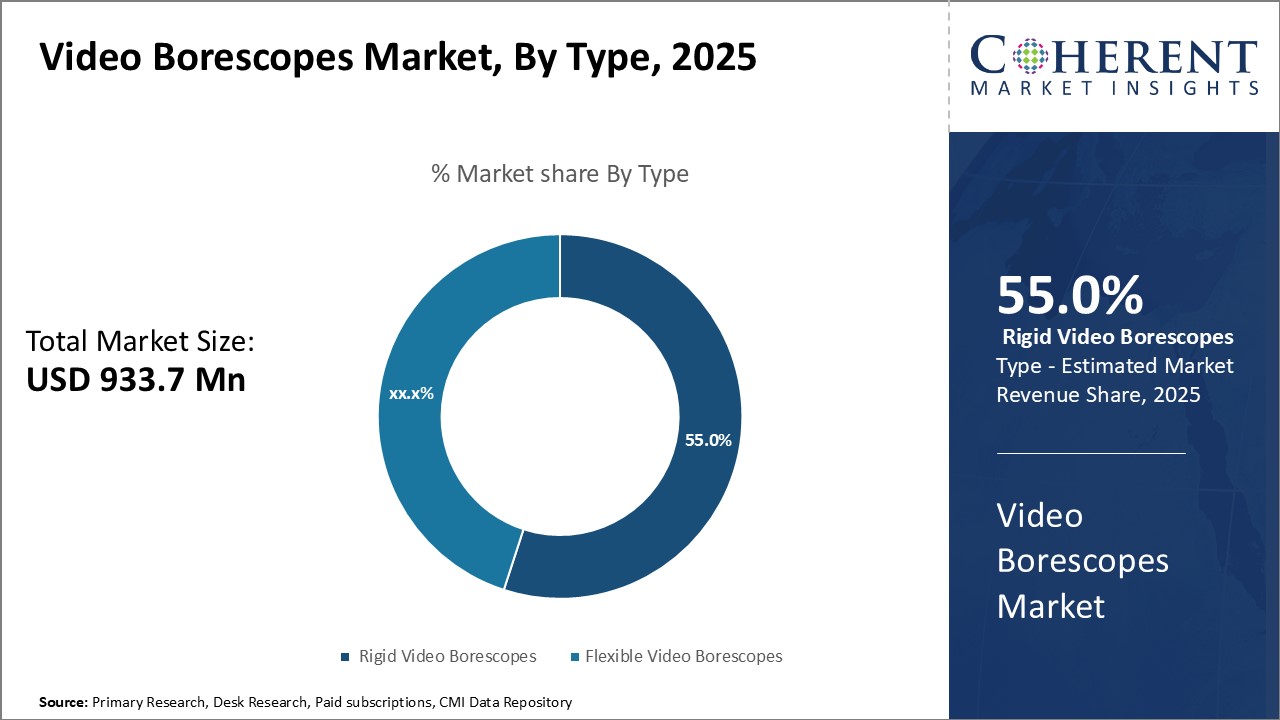Global video borescopes market is estimated to be valued at US$ 933.7 Mn in 2025, and is expected to reach US$ 1,706.8 Mn by 2032, exhibiting a compound annual growth rate (CAGR) of 9.0% from 2025 to 2032.
Global video borescopes market has experienced significant growth, and has become an essential tool in various industries. Video borescopes are versatile inspection devices that allow users to visually inspect hard-to-reach areas remotely. These consist of a flexible insertion tube with a camera at the tip that captures high-resolution video or images of the inspected area.
The market growth is driven by several factors like industries such as automotive, aviation, and manufacturing require efficient and accurate inspection tools to ensure quality control and maintenance of their equipment. Video borescopes offer real-time visual feedback, enabling professionals to identify potential issues or defects in complex machinery or structures. Advancements in camera technology, such as high-definition imaging and wireless connectivity, have further enhanced the capabilities and usability of video borescopes, leading to their increased adoption across various sectors.
Global Video Borescopes Market- Regional Insights
Figure 1. Global Video Borescopes Market Share (%), By Region, 2025

To learn more about this report, Request sample copy
Analyst Viewpoint: Global video borescopes market is expected to witness steady growth due to increasing demand from industries such as automotive, aerospace, industrial manufacturing and power generation. Due to growing importance of inspection activities, more companies are leveraging video borescopes to visually inspect hard-to-reach areas without dismantling equipment or components. North America currently dominates the market followed by Europe due to stringent quality control and safety regulations mandated across industries. However, Asia Pacific is likely to emerge as the fastest growing regional market with growth in China, India and other developing nations.
While development of new advanced non-destructive testing technologies could offer alternatives to video borescopes, their high costs might slow their adoption. Lack of training and skill shortage amongst inspectors is another challenge, restricting wider adoption of visual inspection techniques.
Detecting defects early with video borescope solutions offers users a strong incentive to invest, as it minimizes equipment downtime and associated costs. As product sizes shrink and wireless choices evolve, the range of inspection areas could broaden, enhancing the appeal even more. Rising adoption rates in emerging verticals such as railway and oil & gas also present new opportunities over the forecast period.
Global Video Borescopes Market- Drivers
The aerospace sector has witnessed steady growth over the past few years due to increasing air passenger traffic and cargo movements globally. According to data by World Trade Organization, the world air freight increased by 1.1% in 2021. Airlines and aircraft manufacturers are under constant pressure to ensure safety and minimize aircraft downtime through effective maintenance practices. Video borescopes have emerged as crucial tools for inspecting both the exterior and interior of aircraft engines and assemblies. Their ability to access confined spaces and provide visuals has made these indispensable for detecting flaws in narrow cavities.
The automotive industry has also been growing steadily due to rising vehicle production and sales worldwide. According to the statistics by International Organization of Motor Vehicle Manufacturers, over 93 million vehicles were produced globally in 2021. For automakers, quality control and reducing recalls are top priorities. Video borescopes help to inspect difficult to reach areas inside the engine, transmission, braking systems and other components for defects. Their portable design allows easy inspection of vehicles on the assembly line as well as during routine servicing.
Global Video Borescopes Market- Opportunities
This high economic activity has fuelled the need for inspection and maintenance across various industries like automotive, aerospace, manufacturing, oil & gas and power generation. Emerging nations are significantly ramping up their infrastructure spending to meet the demands of a growing middle class population. For example, according to World Economic Forum, India's national infrastructure pipeline envisions an investment of US$ 1.5 trillion by 2025 in projects across various sectors.
Video Borescopes Market Report Coverage
| Report Coverage | Details | ||
|---|---|---|---|
| Base Year: | 2024 | Market Size in 2025: | USD 933.7 Mn |
| Historical Data for: | 2020 To 2024 | Forecast Period: | 2025 To 2032 |
| Forecast Period 2025 to 2032 CAGR: | 9.0% | 2032 Value Projection: | USD 1,706.8 Mn |
| Geographies covered: |
|
||
| Segments covered: |
|
||
| Companies covered: |
Olympus Corporation, GE Inspection Technologies (now part of Baker Hughes), Karl Storz GmbH & Co. KG, SKF Group, FLIR Systems Inc., Yateks Corporation, PCE Instruments, Vizaar Industrial Imaging AG, VJ Technologies Inc., Gradient Lens Corporation, Medit Inc., RF System Lab (now owned by Olympus Corporation), Coantec Automation Technology Co. Ltd., IT Concepts GmbH |
||
| Growth Drivers: |
|
||
| Restraints & Challenges: |
|
||
Uncover macros and micros vetted on 75+ parameters: Get instant access to report
Global Video Borescopes Market- Trends
Global Video Borescopes Market- Restraints
Moreover, preparing the equipment or areas for internal inspection and setting up of video borescopes is a time intensive process. inserted through small openings or barriers without damaging the equipment. Special provisions have to be made to secure cameras and ensure desired positioning, lighting and focus for quality visuals. All these activities hamper workflow and extend downtime of critical systems undergoing inspection. According to UNIDO Industrial Statistics Database, the average downtime costs for major industrial equipment in developing countries was estimated between US$ 3,000 to US$ 8,000 per hour in 2021. Longer inspection durations significantly increase these costs.
Global Video Borescopes Market- Recent Developments
New Product Launches
Figure 2. Video Borescopes Market Share (%), By Type, 2025

To learn more about this report, Request sample copy
Top companies in Global Video Borescopes Market
Definition: Video borescopes are advanced inspection devices that consist of a flexible insertion tube with a camera at the tip, allowing users to visually examine and record high-resolution video or images of hard-to-reach areas. These are widely used across various industries for inspection, maintenance, and quality control purposes, providing real-time visual feedback and enabling professionals to identify defects, anomalies, or potential hazards in complex equipment or structures.
Share
Share
About Author
As an accomplished Senior Consultant with 7+ years of experience, Pooja Tayade has a proven track record in devising and implementing data and strategy consulting across various industries. She specializes in market research, competitive analysis, primary insights, and market estimation. She excels in strategic advisory, delivering data-driven insights to help clients navigate market complexities, optimize entry strategies, and achieve sustainable growth.
Missing comfort of reading report in your local language? Find your preferred language :
Transform your Strategy with Exclusive Trending Reports :
Frequently Asked Questions
Select a License Type
Credibility and Certifications

860519526

9001:2015
27001:2022


Joining thousands of companies around the world committed to making the Excellent Business Solutions.
View All Our Clients
US Reciprocal Tax Impact Analysis On Video Borescopes Market
Stay updated on tariff changes with expert insights and timely information